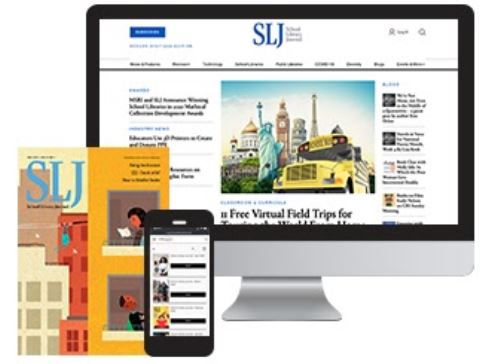2018 School Spending Survey Report
The Gateway Drug | Consider the Source
If the "Harry Potter" books opened up fantasy for generations of readers, what will be the "gateway drug" for nonfiction readers? The author considers Jonathan Hunt's question.
 One of the big questions for nonfiction lovers was posed by Jonathan Hunt a couple of years ago. He suggested that the “Harry Potter” series had opened up fantasy for generations of readers. What kind of book, he asked, would be the “gateway drug” for nonfiction readers? What could/should we offer lovers of those discrete weird-and-wacky fact books as a next step in their reading growth? How can we lead them from record- and list-filled books to inquiry, questioning, and critical reading? Jonathan proposed the Steve Sheinkin model of “reads like a novel” pace and engagement as one answer. I spent my day today with teachers at the Literacy for All conference in Providence, RI, and polled them. An answer emerged that held real promise. Let me know what you think. One 8th grade teacher suggested turning kids loose on researching their own local "Weird But True!" (National Geographic) set of facts and records. Another brought up articles in magazines such as Popular Science, which describe how some interesting object or mechanism is constructed. And today, at a staff development conference in New Jersey, a teacher mentioned how popular the football cookbooks are with elementary school-age boys. She asked why there aren't baseball, basketball, and soccer cookbooks. I answered, "let's have our students write them." As I thought about these exchanges and what they suggested, I saw the answer: making, doing, creating. If, as younger readers, these students gathered stats and facts, a logical extension might be to put information into action by generating something. That something could be building robots, geocaching, producing a public service announcement tackling some social ill, or researching and reporting on a local ecological issue–anything, really. I think this idea holds real promise. Minds that had been actively accumulating can be set loose on instructions, then plans, then competition. As kids create we might offer them biographies of inventors, survivalists, adventurers–people who have impacted the communities and the world they live in. Action paired with models is made doubly relevant because it matches students’ current challenges and interests. I like this version of the “gateway drug” because it does not build a nonfiction reading sequence on patterns drawn from fiction. Of course, page-turning narrative nonfiction has a lot to offer. But that is one option for one set of readers. The information accumulation-to-creation passage begins to explore nonfiction with readers on their own terms. I can easily see how students accustomed to figuring out how to do something would begin to question how someone else has solved a problem. And that is the step “up” to inquiry that waits on the other side of the gate.
One of the big questions for nonfiction lovers was posed by Jonathan Hunt a couple of years ago. He suggested that the “Harry Potter” series had opened up fantasy for generations of readers. What kind of book, he asked, would be the “gateway drug” for nonfiction readers? What could/should we offer lovers of those discrete weird-and-wacky fact books as a next step in their reading growth? How can we lead them from record- and list-filled books to inquiry, questioning, and critical reading? Jonathan proposed the Steve Sheinkin model of “reads like a novel” pace and engagement as one answer. I spent my day today with teachers at the Literacy for All conference in Providence, RI, and polled them. An answer emerged that held real promise. Let me know what you think. One 8th grade teacher suggested turning kids loose on researching their own local "Weird But True!" (National Geographic) set of facts and records. Another brought up articles in magazines such as Popular Science, which describe how some interesting object or mechanism is constructed. And today, at a staff development conference in New Jersey, a teacher mentioned how popular the football cookbooks are with elementary school-age boys. She asked why there aren't baseball, basketball, and soccer cookbooks. I answered, "let's have our students write them." As I thought about these exchanges and what they suggested, I saw the answer: making, doing, creating. If, as younger readers, these students gathered stats and facts, a logical extension might be to put information into action by generating something. That something could be building robots, geocaching, producing a public service announcement tackling some social ill, or researching and reporting on a local ecological issue–anything, really. I think this idea holds real promise. Minds that had been actively accumulating can be set loose on instructions, then plans, then competition. As kids create we might offer them biographies of inventors, survivalists, adventurers–people who have impacted the communities and the world they live in. Action paired with models is made doubly relevant because it matches students’ current challenges and interests. I like this version of the “gateway drug” because it does not build a nonfiction reading sequence on patterns drawn from fiction. Of course, page-turning narrative nonfiction has a lot to offer. But that is one option for one set of readers. The information accumulation-to-creation passage begins to explore nonfiction with readers on their own terms. I can easily see how students accustomed to figuring out how to do something would begin to question how someone else has solved a problem. And that is the step “up” to inquiry that waits on the other side of the gate. RELATED
RECOMMENDED
CAREERS
The job outlook in 2030: Librarians will be in demand
CAREERS
The job outlook in 2030: Librarians will be in demand
ALREADY A SUBSCRIBER? LOG IN
We are currently offering this content for free. Sign up now to activate your personal profile, where you can save articles for future viewing






Add Comment :-
Be the first reader to comment.
Comment Policy:
Comment should not be empty !!!